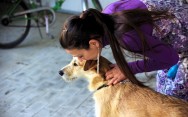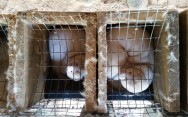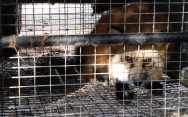Blog Archives
Home -
Posts tagged "Animal Cruelty"
On December 2, 2025, Mexico made a historic leap forward for animal rights by amending its
Constitution to include protections for nonhuman animals. This reform is the first of its kind in the
nation. While many countries have animal protection laws, few have elevated the protection of
animals to constitutional status, and even fewer have extended this to cover all species, including
farmed animals. Mexico’s new constitutional changes mark a groundbreaking shift towards treating
animals as beings deserving of legal recognition and rights, regardless of their species.
In most countries, animal welfare laws are selective, often prioritizing companion animals over those
in agricultural industries. In the United States, for example, farmed animals are often excluded from
protections that apply to pets or wildlife. Mexico’s reforms aim to change that by ensuring all
animals, from farmed animals to those kept as pets, are entitled to legal protection. This
approach could set an example for other nations, particularly in Latin America, where animal rights
movements are gaining momentum. However, with Mexico being one of the world’s top producers
of meat and animal products, it is highly probably that economic interests will hinder the
implementation of these reforms. Agricultural lobbyists could easily push back against these laws to try to
protect profits.
One particularly important aspect of the reforms that could have a positive impact on the future is
education. The changes require the inclusion of animal welfare education in Mexican schools. In the
best-case scenario this could influence a new generation that values and understands animal rights.
It could be the first step in changing cultural attitudes towards animals on a larger scale. While the
specific details of this educational shift have yet to be defined, the hope is that it will lead to a
transformation in how Mexican society views and treats animals in the future.
The constitutional amendment represents a step forward in recognizing animals as sentient beings
with rights, but the true test will be in the details. It is unlikely that Mexico will go far enough in
creating strong, enforceable laws that truly afford equal protection to animals. On the other hand,
this victory sends a message about the direction society is capable of going if social imagination can
conceive of animals as equal beings to humans. There are many self-interested forces at work trying
to convince humans that it is too difficult to value animals in parity to ourselves, that there are too
many problems or steps to be taken, and true equality for animals is not possible. Legislation at a
constitutional level proves that changes can be far-reaching and can affect all animals.
At Freedom 4 Animals, our work includes both education and advocacy. Both of these things
contribute to change, as people learn about our fellow inhabitants of this earth and how we can
elevate their status as beings worthy of equal consideration. Please read more about our work to
educate the public and fight for animal freedom.
Despite some positive progress in legislation, puppy mills are still a big source of cruelty and neglect,
a fact that is all too real for thousands of dogs across the United States. The ASPCA’s recent poll
revealed that the most important issue for supporters in 2025 is fighting for stronger legislation to
protect puppy mill victims. Large-scale commercial breeding operations continue to operate under
outdated and inadequate regulations. People are beginning to wake up to the fact that this cruelty is
still legally sanctioned, but we are a long way from liberating dogs from puppy mills.
Puppy mills are notorious for their appalling conditions, with many dogs confined to tiny, wire cages
barely large enough for them to turn around. These facilities, which are regulated by the U.S.
Department of Agriculture (USDA), often fail to meet even the most basic welfare standards. Female
dogs are bred relentlessly, producing litter after litter without adequate time for rest and recovery.
Even with laws on the books, these standards are rarely enforced, and commercial breeders that
neglect their animals continue to operate unchecked.
Even the lucky ones who are adopted and rescued from lives of forced breeding have stories of
trauma, their bodies ageing faster than is normal for a well-cared-for dog. Read about the story of
Gracie, a dog who was rescued after 6 years of breeding 100 puppies:
https://www.humaneworld.org/en/blog/mama-dogs-story-why-we-do-work-we-do-stop-puppy-
mills
There have been recent wins, including the passing of the New York Puppy Mill Pipeline Act in
December 2024. This New York legislation bans the sale of cruelly bred pets in retail stores. The
ASPCA report outlines a commitment to building on this momentum by pushing for similar
legislation in other states in 2025. The ASPCA also advocate for Goldie’s Act, a bill that would require
the USDA to enforce stronger oversight of federally licensed facilities, ensuring more frequent
inspections, intervention for animals in need, and better coordination with local law enforcement.
The road to eliminating puppy mills is long, but with continued advocacy, we can reduce the
suffering of countless animals. The fight is far from over, and it’s imperative that we keep working
together to ensure that no dog ever has to endure the horrors of a puppy mill again.
Please read more on the ASPCA Website: https://www.aspca.org/news/poll-results-revealed-which- animal-welfare-initiative-was-voted-most-important-aspca-supporters
For more information about our work at Freedom 4 Animals to educate the public and push for
animal freedom, please click to read: https://www.freedom4animals.com/the-empathy- program/
|
Tags: Animal Abuse,
Animal Advocacy,
Animal Cruelty,
Animal Freedom,
animal rights,
ASPCA,
Commercial Breeding,
Forced Animal Breeding,
Gracie's Story,
Kevin Boileau,
Nazarita Goldhammer,
New York Puppy Mill Pipeline Act,
Puppy Mills,
USDA
Greyhound racing is a cruel sport. Deaths, injuries and exhaustion are the norm. The animals’ natural
speed and abilities are harnessed in this nonconsensual sport that brings in millions for the industry
and sports fans, but ruins dogs’ lives. The sport is so hard on animals, that many US states and some countries have banned it . New Zealand is poised to be the latest country that bans greyhound racing. In Ireland, greyhound racing still receives 20 million every year in funding.
Every year, dogs die, grist to the mill. In 2024, the death toll of greyhounds at Irish race tracks
increased by 60%. 96 greyhounds were either euthanized or died of a racing injury on Ireland’s racing tracks between January and the end of June 2024 in Ireland. In previous years 60 animals were euthanized or died of a track-inflicted injury during the same time period. It’s an unacceptable amount of deaths in a “so-called sport” that is funded by taxpayer money.
It’s almost impossible to imagine a sport where humans frequently die or push themselves so hard
that they are too worn out to even retire after the sport. Of course we don’t euthanize humans
when they are no longer useful. And even the most demanding or dangerous human sports are
pursued voluntarily, whereas animals are engaged in sports without their consent.
A spokesperson for Greyhound Racing Ireland explained the deaths away as a result of an increase of
dogs being raced in the country. This only makes it clearer that greyhound racing is a sport that
sends dogs to their death.
Animal Welfare advocates have repeatedly criticized the Irish government’s funding of greyhound
racing. Greyhound racing receives more guaranteed funding than any other sport in Ireland. The
obvious conclusion from this is that greyhound racing is big business for the country: it’s easy money
for an industry that doesn’t have to pay its athletes or guarantee their welfare.
In even worse news for Irish greyhounds, Irish greyhounds are being exported to India to participate
in an incredibly cruel craze that involves racing greyhounds against motorbikes. This open animal
cruelty, known as “motorbike lure coursing” races dogs to exhaustion and exposes dogs to the
danger of being mangled in an accident.Just like humans, animals are capable of amazing physical feats. They enjoy testing their abilities, being competitive and playing with other animals. However unlike humans, they are forced to engage in sporting activities without their consent. Until we can communicate with animals to understand their needs and desires, involving them in sporting activities that are cruel
and punishing is not sport – it’s animal cruelty. At Freedom 4 Animals we believe that animal freedom demands that we consider animals as beings of equal significance, with equally valid needs, desires and agency. Read more about our educational programs and animal advocacy.
Please sign the petition to stop horse-racing in Ireland.
After Kristy Noem boasted about shooting her puppy in cold blood, now there are reports that right
wing figurehead Kevin Roberts told several people that he killed a neighbor’s dog with a shovel to
stop her from making noise.
The dog, Loca, disappeared in 2004, the year Roberts was alleged to have boasted about killing her.
It’s impossible to verify whether the story is true or not but there is evidence that casts suspicion on
Roberts.
The chair of the history department at New Mexico State University where Roberts worked recalled hearing the story, as did two other people, a professor andher spouse and three others who said they heard the account at the time from others. Roberts hadn’t said the dog was a danger, according to these reports, he had just said the dog was loud, and he appeared proud of what he had done.
Roberts named the neighbor who owned the dogs, Daniel Aran, and claimed that animal control had
come to rescue multiple dogs from the property, casting himself as a concerned neighbor, as well as
citing that Aran went to prison for cocaine distribution. Aran and his mother denied that animal
control had come to rescue any dogs. They both said they had a dog go missing around 2004, the
year when Roberts boasted about killing a dog. They spoke with affection about their dog, “my little
Loca.” Aran said Loca had been his favorite dog. “She was a little, little thing like this,” Aran said.
“She was a tiny, cute little thing.”
Aran said he and his mother went searching for the dog but could never find her, and dog catchers
weren’t able to find her either.
We will never know what happened to little Loca, or what she had to endure in her final moments.
Despite concerning evidence, this cold case will never go investigated and little Loca’s mystery will
not be solved. Any justice that may be due to her will not be served.
Although we have no way of knowing whether these allegations are true, it’s a chilling story that
should serve as a reminder that animals do not receive the same treatment in the criminal justice
system that humans do. Loca deserved better than this.
At Freedom 4 Animals we work with lawmakers, nonprofits, animal rights groups, and individuals to
seek justice for animals and their human custodians who have been harmed, and to advocate for
animal rights within the criminal justice system and beyond. We work to educate the public and
anyone who is interesting in learning about animal rights about the role of animals in society and
how we can re-address those roles to achieve freedom and equality for animals.
To learn more about how animals are treated differently in the criminal justice system and how
violence to animals predicts other forms of violence, please visit the resources on our website.
South Dakota governor Kristi Noem has made headlines for boasting that she shot and killed her dog
in cold blood. Noem’s story was intended to paint her as a “no-nonsense” person who had no
problem doing what was necessary. In the same chapter, Noem also wrote about how she shot her
goat in cold blood. Public opinion shows that this has not worked out in her favor. The cold-blooded
killing of a companion animal who relied upon and trusted a human, apparently doesn’t look that
good to the public.
Dogs are human beings’ closest companions and our history has been symbiotic with them for
Millennia. Yet dogs are often the first victims of humans’ failure to take responsibility for this
relationship, as when dogs are euthanized if they attack another animal or a human, or appear to
pose a threat to property and safety. Poor training by human owners and misunderstanding of their dog companions instill trauma and aggressive behavior resulting in the dog’s misbehavior or failure to live up to human expectations.
In her autobiography, Kristi Noem shared how she shot a 14 month old wirehaired pointer named
Cricket who had come to her family with behavioral problems. Noem went as far as to say that she
“hated” the dog. She made no attempt to deal with her own feelings. Instead, her dog Cricket,
immediately became responsible for how she felt, justifying Noem’s execution of the dog. The story
was intended to convey that Noem was a tough person who understood life in rural America. Her
lack of remorse for the killing simply revealed that Noem didn’t care about the dog’s life.
Noem shot her dog Cricket after Cricket prematurely chased birds on a pheasant hunt, then jumped
out of Noem’s truck and mauled chickens on a neighbor’s property. Cricket was free to attack the
chickens, because Noem had failed to secure Cricket in the truck. Successful dog trainers and experts
agree that a dog’s behavior and conduct is the responsibility of the owner, and dogs who misbehave
can behave better with different interventions and understanding.
People who have dogs and other animals as companions have a responsibility to
their pets to act with empathy and patience. Neglect and cruelty affect a dog’s behavior as much as
they do humans. At 14 months old, Cricket was a young dog, a puppy, who deserved care and
guidance. Instead, her life was cut short by her care takers disregard for her life.
The backlash against Noem’s story shows that people will no longer accept a narrative that
blames animals for human issues. We must make a choice to extend our compassion to
other animals, beyond companion animals like cats and dogs. Cricket made headlines, but Noem also
shot her goat. No animal should have to take responsibility for an abusive human’s behavior by
paying the ultimate price.
Animal cruelty and protection laws are often notoriously selective. Who we protect and why often says more about humans’ relationship to animals than what the animals need or deserve. In Wyoming, a man who tortured a wolf is not responsible because Wyoming’s animal cruelty laws don’t protect predatory animals.
Wyoming’s animal cruelty laws only apply to domestic animals and pets, not “predatory animals.” Animal cruelty charges and penalties can’t protect these animals from the “the hunting, capture or destruction of any predatory animal or other wildlife in any manner not otherwise prohibited by law.”
What allegedly happened to the wolf in Sublette county is something that many people would view as the work of a sociopath or budding serial killer. The torture was calculated. The wolf was tortured for an extended period, and there was humiliation involved. The wolf was allegedly run down by Cody Roberts in a snowmobile, humiliated and displayed at a local bar while disabled, and then shot at the same bar. This prolonged injury, torture and death is something that would be considered unconscionable if it happened to a human. The violence is shielded however, by the acceptance of hunting animals, and protected by outdated laws.
An investigation into animal cruelty surrounding the incident is now underway, but the County Prosecutor has said that according to Wyoming Law it is legal to hunt a predatory animal by running it down in a snowmobile or another vehicle. The investigation will determine whether, legally, animal cruelty has taken place.
Before the public outcry drew attention to the incident, Cody Roberts received nothing more than a 250 dollar fine for the possession of live wildlife.
Grey wolves in Wyoming lost federal protection in 2012 and 2017 and animal rights groups are now suing the United States Federal Wildlife Services to restore protections for wolves in the state. The status of predators or dangerous animals in the human pantheon of wildlife we deem worth protecting is often low. We view these animals as historic enemies, or a threat to livestock and economic productivity, or merely existing to be hunted for sport. Wolves are individuals who relate to each other in a highly social manner and have histories and relationships that can last years. All beings are deserving of protection. The mythology of wolves is maintained from a violent human centered perspective that must be transformed through education, activism and compassion.
https://cowboystatedaily.com/2024/04/04/wyoming-animal-cruelty-laws-dont-apply-to-alleged-wolf-torment-case/
Using hidden cameras in agricultural facilities is still one of the best ways to reveal the horrific cruelty of industrial agriculture. This is why states continue to pass “ag gag” laws to restrict and punish any exposure of practices at agricultural facilities.
An animal rights group, Mercy for Animals, used hidden surveillance to protest Senate Bill 16 in Kentucky, which aims to criminalize the use of recording equipment such as drones, cameras, video recorders, audio recorders etc. inside concentrated animal feeding operations. In doing so they exposed exactly the reason why criminalizing these practices shields violence and cruelty from the public eye.
Workers are known to abuse animals horribly at industrial agriculture facilities, and the farms that Mercy for Animals exposed were no exception. The group released videos showing workers kicking, stepping, throwing and stuffing chickens into cages for transport. The farms are described as contract farms providing chicken to Pilgrim’s Pride, one of the largest chicken producers in the United States.
Large industrial farms continue to claim that animals are killed humanely, and any problems are the result of bad apples. But the scale of cruelty and killing at these farms reveals that it is the norm for workers to dehumanize animals and abuse them before killing them. This is part of a psychological process that is not separate from industrial farming, it’s normalized by workers exposed to violence every day as part of their job. Animal rights groups continue to expose these conditions, and the farming groups protest that the problem is the individuals involved, and not the industrial scale of the killing operation itself.
One of the key tools animal rights activists have at their disposal is drones, which are cheap and capable of recording poor conditions, animal abuse and illegal hunting. Footage captured by drones has led to many successful campaigns on behalf of animals.
If blocking surveillance of animal rights abuses were just protecting private property, why is it that industrial farming interests are always behind these laws? The cruelty that we see on footage obtained by animal rights groups is clearly a fraction of what actually exists. We must continue to fight for the right to expose horrific cruelty and the lies of the industrial farming industry.
South Korea’s dogmeat trade has long been a national source of shame, especially to younger
people, who have developed more progressive views about animals. Pets such as domestic dogs and
cats have become more popular, changing people’s views of dogs as disposable animals that can
be farmed for meat. The dogmeat trade has been dying out on its own, but it has lingered on. The
dog meat trade is incredibly cruel and dogs are often killed in extremely painful ways. Dogs are kept
caged and suffer cruel conditions where they see other dogs killed. As social animals, this must be
unbearable to them.
Last year, South Korea’s parliament voted near unanimously to ban the dog meat industry. The law
takes effect in 2027 and will ban any future slaughter breeding and sale of dogs for dog meat.
The consumption of dog meat is based on historical traditions and unscientific beliefs about the
health benefits of dog meat. One of the most horrifying things about these traditions is that dogs are
deliberately tortured before death because of the belief that the adrenaline levels in the animal will
contribute to health benefits. Although dog meat was traditionally eaten in South Korea in the past,
there is evidence that this was not widespread and it became more popular due to false beliefs
about its effects on virility in older men. Animals have long been tortured because of human crazes
and the dog meat industry is a particularly cruel example. Not only are animals farmed for dog meat
but also abandoned pets are collected from the streets and slaughtered for the dog meat trade.
Activists inside and outside of the countries where dog meat is eaten have protested the practice.
On the other hand, condemning the practice has been associated with anti-Asian racism in incidents
in the US where restaurants have been falsely accused of selling dog meat. Consuming dog meat is
not “barbaric” because of a country’s culture, it is barbaric because humans are capable of extreme
cruelty towards animals when it is in their own interests.
Although it’s positive that dogs will be protected from this horrific cruelty in the future, the dog
meat ban should not draw attention away from the suffering of all animals such as cows, which in
Western culture are slaughtered for meat while in Korean culture traditionally were not killed and
kept as work animals. Animal rights activists and philosophers have argued against “speciesism,” in
which some animals are considered more deserving of safety than others. Banning dog meat is a
reflection of the public’s increasing intolerance of cruelty toward animals that are kept as pets.
Ultimately we must fight for animal rights to be extended beyond pets and towards all animals.
|
Tags: Animal Breeding,
Animal Cruelty,
animal rights,
Animal Suffering,
Cruelty to Dogs,
Dogmeat Industry,
Kevin Boileau,
Nazarita Goldhammer,
Speciesism,
Transhumanism,
Vegan
Animal welfare services are investigating the Ontario marine park where 14 whales and 1 dolphin have died in the space of a few years. The park is a big employer in the area and it has denied any wrongdoing, including any water quality issues that could have led to deaths at the park.
The park has a vested interest in keeping animals in roles where they are visible to the public, and formerly held shows in which its animals performed tricks and members of the public could feed its animals.
During a 2 year period, 12 beluga whales died. At the same time, provincial authorities had raised concerns about the park’s water quality and had recognized that all of the marine mammals were in distress. There have been protests and demonstrations for many years against the treatment of animals in the park. Citations against the park have resulted in 5 counts of animal cruelty by the Ontario Society for the Prevention of Cruelty to Animals in 2016 and 6 counts of cruelty by the OSPCA in 2017.
The animals that died include a beluga whale named Ikora, who died on October 24th 2019 and 10 others including a beluga named Bull, who died on November 23, 2021. 3 more deaths were confirmed in 2023, including Kisko, who was called “the world’s loneliest whale.” She was the last killer whale in captivity in Canada, and was originally captured along with Keiko, the star of Free Willy. She endured loneliness throughout her life in captivity, as she was confined to a small tank without companions. She died at the age of 47. The other animals who died in 2023 were a dolphin and a whale.
At one time Marineland had the most captive belugas in the world. Since Canada passed a law phasing out marine captivity, the park was forced to adjust. It is now shifting towards educational efforts. The animals are no longer available to the public and forced to perform tricks.
The lack of information surrounding the deaths of these animals obscures the conditions they may have been living in before they died. Captivity not only exposes animals to psychological risks of loneliness and confinement and the psychological pressure of being on display, animals could also suffer from neglect, poor environmental conditions and chronic health issues. Marine animal captivity should not be the norm unless it is explicitly for conservation purposes. The profit bottom line too often exposes animals to the risk of cruelty and neglect.
It’s no secret that the meat industry is trying hard to improve its image. As research continues to demonstrate the impact of meat and milk on greenhouse gas emissions, lobbyists for the livestock industry have been working to develop a counter-offensive.
The Protein Pact was launched in July 2021 and consists of mostly U.S. based livestock industry firms. The National Pork Producers Council is one of these groups, which challenged California’s Prop 12 before the Supreme Court and lost. The council’s president made headlines recently when he said he wouldn’t comply with even the modest animal welfare requirements of California law.
Chances are, you might have noticed a significant backlash against plant-based proteins and “fake meat” in the last year. There are strong indications that the meat industry has positioned influencers, dietitians and other messengers to influence public opinion on the benefits of meat. The Protein Pact organization works with Red Flag Consulting which is known for its efforts to interfere with climate policy action in the EU.
The group has also funded academic research to promote their claims. U.C. Davis’s CLEAR center, is funded in part by pact partner IFeeder and has been the subject of multiple investigative news stories, including one published in the New York Times, about its misleading communication efforts. Other controversial figures like Richard Berman are named in articles about the backlash against vegan meat. The Berman PR company has been involved in defending industries such as big tobacco.
“Big meat” has an image problem that can’t be whitewashed. It revolves around the cruel treatment of animals in industrial farms, as well as the harm the industry causes the planet. The industrial production of meat and exploitation of animals makes up 15% of global emissions and 60% of food production emissions. It’s no surprise that moves away from big meat and towards plant protein would be met with attempts to stifle these efforts.
It’s important to remember that influencers make their money from paid sponsorships and so-called candid advice may be funded by less than above-board sources. Articles with knee-jerk titles that claim to debunk veganism and vegan protein could well be part of a backlash that is more about business interests than science. Vegans can help to combat this disinformation by carefully fact-checking and tracing the sources of articles sent my family and friends.
|
Tags: Animal Cruelty,
Animal Protein,
animal rights,
Industrial Farming,
Kevin Boileau,
Meat Industry,
Nazarita Goldhammer,
Plant Protein,
Protein Pact,
Transhumanism,
Vegan,
Vegan Meat,
Wellness Influencers








Social Media